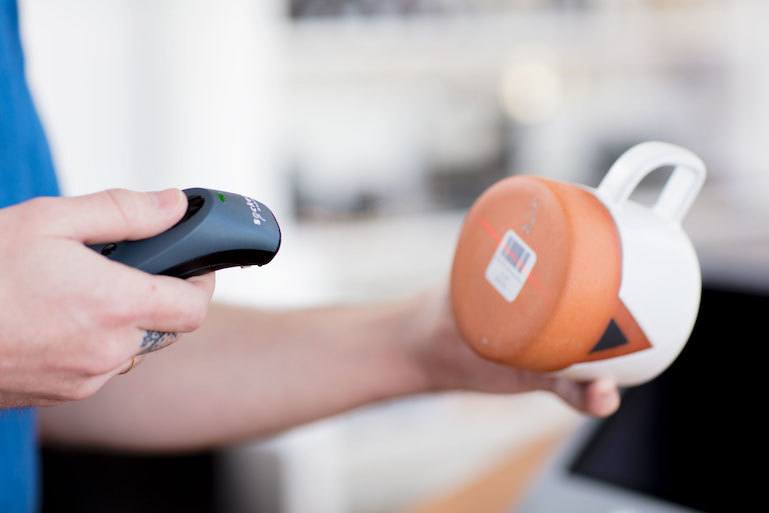
Everything You Need To Know About How Barcode Scanners Work
You’ve undoubtedly seen barcode scanners before. They’re the tools that cashiers use to checkout customers at a store.
The staff member scans the barcode that’s attached to a product, quickly adding it to an order or transaction. Simple enough, right? In this case, it is. But barcode scanners are far more than simple business tools. The reason? If you think about it, barcodes are everywhere.
They’re on the packages we get in the mail. They’re part of social media apps. And you might have seen them in print or billboard advertisements. You can even scan more advanced codes like QR (Quick Response) codes with a mobile device like your smartphone.
As a new business owner or an experienced one that’s looking to get more tech-savvy, it might be hard to understand how barcodes and barcode scanners can fit into your business. The good news is that it’s pretty easy to pick up with a little explanation. That’s what we aim to provide in this post. At the end of it, you’ll understand the different types of barcodes and barcodes scanners available to you as a business owner, as well as some ways you can use them to improve your performance and better understand how your business works.
What Is a Barcode?
To understand how barcode scanners work, you first need to understand how barcodes work. A barcode is a scannable code with a numeric counterpart at the bottom. It features a pattern of parallel lines that are typically black against a white background. Although, that’s not always the case.
This pattern of black lines and white spaces stores the data. Once a barcode is scanned with a barcode scanner, or a smartphone in some cases, the data is translated into readable information. Typically, this information is displayed on the screen of a POS system. So, to add an item to an order on a POS system, all a cashier has to do is scan the barcode. Then, information about that item such as its name and price pop up on the screen. Much simpler than keying in this information manually.
The set of numbers at the bottom of a barcode is called a Universal Product Code (UPC). The parallel lines of a barcode are the scannable version of a UPC. All of the information attached to a barcode is contained within the string of numbers. The parallel lines are the machine-readable version of it. Barcodes can store all kinds of information, but ina retail business, they’re mostly used for inventory and merchandise data, as well as for recordkeeping via purchase receipts.
Barcodes for Inventory Management
Using barcodes makes it much easier to organize and manage your inventory. For a smarter approach to organization, you can label each piece of inventory with a unique UPC. That UPC can correspond to another code on your storage shelves, so you always know what goes where.
Barcodes help with inventory management because they make it easier for business owners to know how much of a product they have in stock. You can do a quick inventory count by scanning the barcodes on your boxes instead of manually totaling up inventory with pen and paper. You can use the same process to quickly update inventory counts when you receive new stock from suppliers.

Barcodes for Faster Purchases
One of the more obvious ways that businesses use barcodes is in sales transactions. Instead of keying in an item code, price, and quantity manually, all that a cashier needs to do is scan the barcode of the items the customer is purchasing. This results in quicker checkouts and fewer mistakes when ringing up customers. In doing so, the overall checkout experience becomes a more efficient and pleasant process for both the cashier and the customer.
SEE ALSO: Small Business Basics: What is a Point of Sale Transaction?
Barcodes for Receipts
Some POS systems will print a barcode at the bottom of a receipt as a way to store the information from a transaction. This can include the register where the transaction took place, the name of the cashier, the method of payment, the items a customer bought, and what each item cost. It might even include information about your loyalty program if the customer is a member.
This type of barcode makes it easier for a retailer to look up specific purchase information to better track their business. It’s also commonly used to process returns or exchanges. Instead of a cashier locating a purchase record by manually searching for a specific order number, they can simply scan the barcode.
Other Types of Barcodes
You can even find barcodes outside of the retail world. Several social media apps use a more advanced version of a barcode as a way of identifying a user, kind of like a username. For example, if you want to add a friend on Snapchat or Facebook Messenger, all you have to do is place your phone’s camera (while in the respective app) over that person’s unique code to add them to your friend list.
UPC vs. SKU
It’s also worth discussing UPCs vs. SKUs. Plenty of new retailers mistakenly believe that a Universal Product Code (UPC) and a Stock Keeping Unit (SKU) are one in the same. While they do have things in common, it’s important to note their differences, as well as what those differences mean for your business.
Both numbers are numerical identifiers for products. However, a UPC is meant to be a universal code. It’s used to identify a product regardless of where it’s sold. Here’s an example, a box of your favorite brand of cereal will have the same UPC whether you buy it in your hometown or the next state over. This universal nature is what makes UPCs and barcodes so useful for quickly entering new inventory into your POS system or ringing up purchases. Everything is standardized, preventing mistakes.
A SKU, on the other hand, is a number that is unique to a company and is mainly used for back-of-house operations like managing inventory. The big difference is that you are in control of your SKUs. You create them and can use them to track as much information about a product as you want, within reason. Depending on your internal processes and technologies, this can give you greater freedom and flexibility with how you track and manage your inventory. It can also help you gain greater insight into the performance of your inventory.
It’s also important to note that this isn’t an either-or proposition. Most businesses use both, and in all likelihood, so should you. How you do so will depend on the inventory management tools that you use, as well as the methodology you use for tracking inventory.
Where to Get Barcodes, UPCs, and SKUs
This will depend on the inventory management or point of sale system you’re using. For example, ShopKeep customers can create their own UPCs and SKUs within specific guidelines when they add new items to their inventory. Barcodes are automatically generated from those items when a customer prints a label with ShopKeep’s label printing capabilities.
What Is a Barcode Scanner?
A barcode scanner is a device used to read barcodes. Most businesses buy scanners for use during the checkout process. However, as we’ve discussed, they are also used for inventory management, whether that’s in your store or within a larger warehouse setting.
Types of Barcode Scanners
There are many different scanners and scanning technologies on the market today. The most commonly used variants consist of a red light source or laser that reads the data from barcode labels and feeds it into the POS system. The technical name for a scanning device that uses lasers is a Charge Coupled Device, also called a CCD reader or CCD scanner.
However, recent technological advances now allow smartphones to function as barcode readers through their camera functionality. One typical example of this in action happens in Apple’s retail stores. If you order something for in-store pickup, you’ll get an email that includes a QR code. Once you get to the store, an employee will scan this code to look up your order so that your purchase can be brought out to you.
On the consumer side, you’ll find this functionality used in retail apps to facilitate online shopping. Department stores like Macy’s and Target give the customers the option to scan items while in-store to check prices and look for deals. Similarly, Amazon app users can scan the barcode of any item around them to look it up and purchase it from Amazon.
1D and 2D Scanners
The scanners that retail businesses typically use fall into two major categories: One-dimensional (1D) and two-dimensional (2D). 1D scanners are the more traditional model. They can scan the standard barcodes you’re most familiar with. 2D scanners, however, can scan both barcodes and more complicated codes like QR codes. The one you choose depends on the type of codes you want to use, as well as your budget.
Why Use a Barcode Scanner?
Who wants to type in all those numbers by hand? Scanners save a significant amount of time for the cashier and the customer. A cashier can easily scan barcodes to checkout customers much faster than they could otherwise. They also help eliminate errors by preventing a cashier from accidentally typing in the wrong code or price. This combination of speed and accuracy is essential in a retail industry that’s overflowing with options. If you can’t deliver the level of service your customers expect, then they’ll shop elsewhere. Barcodes and scanners might not be the first things you think of when you hear customer service, but they do deliver.
SEE ALSO: How to Set Up a Barcode Scanner for a More Efficient Checkout
What Kind of Barcode Scanner is Best?
The kind of reader you choose depends on the type of business you run. Scanners connected to a POS system via cords are cheaper than ones that connect over Bluetooth. They make sense if a cashier is standing in one place for long periods of time.
However, a Bluetooth reader is the better choice in a space where movement is limited. A cordless scanner is also helpful if you sell large or heavy items. Your cashier can scan items without having to lift or move the object around to get at the barcode. If you aren’t sure which is right for you, most modern POS systems like ShopKeep have a variety of scanner options and accessories available to choose from based on your unique needs.
As far as 1D vs. 2D, 1D scanners are best for traditional linear barcodes, but be aware of what that could mean for your business. If your target audience is a younger, tech-savvy crowd, or if you give customers the option of emailed receipts, a 2D scanner might be better. These scanners can read barcodes and QR codes directly from your customers’ smartphone screens. This allows you to use these codes in your marketing and customer outreach for promotions and sales. This can help you track the performance of these promotions because your POS or marketing tool will record each scan of the promo code.
Lastly, each reader has different setup instructions, and not all are compatible with every POS system. If you already have a POS system, be sure to buy a scanner that’s compatible with it.
All of this can seem complicated at first glance, but understanding barcodes and how to integrate them into your business can make things easier on you, your management team, and your front-line staff. They enable faster checkouts, more efficient inventory management capabilities, and highly trackable promotional campaigns. If you’re new to retail, no one’s saying that you need to institute personalized QR codes immediately or buy a 2D scanner out of the gate. But adding basic barcodes to your products will almost certainly make a world of difference to your overall success.
Want to try ShopKeep for yourself?
Just answer a few easy questions.
Need help finding the right point of sale?
Just complete the form. We’ll call you right back to explain how ShopKeep can work for you.
Hit the ground running.Sprinting, in fact!
Read our free, comprehensive guide, Small Business 101, to learn all you need to know about starting a thriving business.

